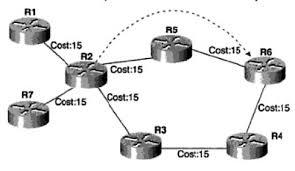Why do you need MPLS Traffic Engineering? - MPLS TE is a mechanism that provides cost savings in an MPLS networks.
How cost saving can be achieved ? How traffic is steered to the paths which wouldn’t be used in normal circumstances ? I will explain in this post.
For more detail about MPLS TE and any other MPLS topics, you can check our MPLS Training.
Let’s look at below topology.

Figure - MPLS Traffic Engineering
Even if you enable MPLS (Without Traffic Engineering, which mean without RSVP) on the above topology, MPLS follows the IGP shortest path decision, thus , top path is used and the down path stays as an idle.
So although you have the capacity on the below path between R2 and R6, it is not used because of higher total IGP cost. (LDP always follows IGP’s shortest path for the traffic between source and the destination)
MPLS Traffic Engineering is enabled by RSVP (Resource Reservation Protocol). RSVP has been extended to support MPLS TE and it is called RSVP-TE. Important extensions are label advertisement and source routing capabilities.
So, if you have an MPLS network today, maybe to provide VPN (LDP is the label distribution protocol in many cases) , you can’t have MPLS TE without enabling RSVP-TE (There is a centralised MPLS Traffic Engineering approach which doesn’t require RSVP-TE, but this is the topic of another blog post) you can’t have Traffic Engineering.
As you can see, overall idea (At least the initial use case) of MPLS Traffic Engineering is to use all the available paths between source and the destination in your network, efficiently.
In the above topology, if you wouldn’t send the traffic over down path, you had to increase the bandwidth capacity of the top path although you have an idle capacity in your network. By enabling MPLS TE, you achieve cost savings.
Today (As of June 2017), MPLS-TE is used by many companies either for above reason or just for traffic protection (Fast Reroute) purpose which I will explain in a separate post.
What kind of topologies require MPLS TE?
What are the other advantages?
How this solution technically works ?
I will answer all these questions in the individual posts, check MPLS category from the right sidebar menu of the orhanergun.net/blog
By the way, food for thought. Do you think is MPLS Traffic Engineering only mechanism to send the traffic to the alternate path (down path in the above topology) ? Check ‘ Why you should place less emphasis on MPLS TE post after you think about it, at least a minute.


